Search results for: 'handle sew'
- Related search terms
- sewing
- sewing ma
- sewing machin
- Sewing machine
- Sewing t
-
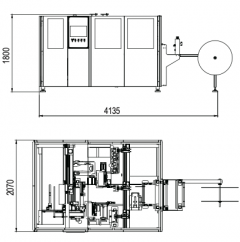 YY-3034 FULLY AUTOMATIC VERTICAL MATTRESS HANDLE ATTACHING MACHINE INCLUDING THE LABEL ATTACHMENT AND END SEWING TOGETHER, SEWING WIDTH 120 TO 450mmYY-3034 FULLY AUTOMATIC VERTICAL MATTRESS HANDLE ATTACHING MACHINE INCLUDING THE LABEL ATTACHMENT AND END SEWING TOGETHER, SEWING WIDTH 120 TO 450mm TECHNICAL PARAMETERS: SEWING WIDTH: 120 TO 450mm (4.7 INCHES TO 17.7 INCHES) SEWING THICKNESS: ≤25mm (ONE INCH) PRODUCTION CAPACITY: 4~6M/MIN (7 TO 8 YARDS PER MINUTE) TOTAL POWER: 8KW POWER SUPPLY: 220V QUANTITY: 1 Learn More
YY-3034 FULLY AUTOMATIC VERTICAL MATTRESS HANDLE ATTACHING MACHINE INCLUDING THE LABEL ATTACHMENT AND END SEWING TOGETHER, SEWING WIDTH 120 TO 450mmYY-3034 FULLY AUTOMATIC VERTICAL MATTRESS HANDLE ATTACHING MACHINE INCLUDING THE LABEL ATTACHMENT AND END SEWING TOGETHER, SEWING WIDTH 120 TO 450mm TECHNICAL PARAMETERS: SEWING WIDTH: 120 TO 450mm (4.7 INCHES TO 17.7 INCHES) SEWING THICKNESS: ≤25mm (ONE INCH) PRODUCTION CAPACITY: 4~6M/MIN (7 TO 8 YARDS PER MINUTE) TOTAL POWER: 8KW POWER SUPPLY: 220V QUANTITY: 1 Learn More -
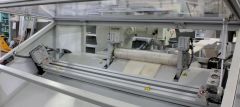 K-4945 AUTOMATIC MATTRESS HANDLE SEWING MACHINEREFERENCE NUMBER: K-4945 AUTOMATIC MATTRESS HANDLE SEWING MACHINE BROTHER 326G MANUAL HANDLE FED AUTOMATIC HANDLE BENDING AUTOMATIC HANDLE LOADING AND SEWING AUTOMATIC MEASURING AUTOMATIC BORDER CUTTING QUANTITY AVAILABLE: 1 Learn More
K-4945 AUTOMATIC MATTRESS HANDLE SEWING MACHINEREFERENCE NUMBER: K-4945 AUTOMATIC MATTRESS HANDLE SEWING MACHINE BROTHER 326G MANUAL HANDLE FED AUTOMATIC HANDLE BENDING AUTOMATIC HANDLE LOADING AND SEWING AUTOMATIC MEASURING AUTOMATIC BORDER CUTTING QUANTITY AVAILABLE: 1 Learn More -
 M-3009 ATLANTA ATT 3300R AUTOMATIC BORDER MEASURE, SEW AND HANDLE ATTACHING MACHINE WITH LABEL GOVERNMENT LABEL ATTACHING
M-3009 ATLANTA ATT 3300R AUTOMATIC BORDER MEASURE, SEW AND HANDLE ATTACHING MACHINE WITH LABEL GOVERNMENT LABEL ATTACHINGREFERENCE NUMBER: M-3009
ATLANTA ATT 3300R AUTOMATIC BORDER MEASURE, SEW AND HANDLE ATTACHING MACHINE WITH LABEL GOVERNMENT LABEL ATTACHING
BAND AND HEALTH MACHINE
8 POSITIONS TO PUT THE SPOOLS WITH THE HANDLE MATERIALS.
AUTOMATIC HANDLE TACKER, BORDER MEASURE, INSERT LAW LABEL AND CLOSE WORKSTATION
BRAND: ATLANTA ATTACHMENT
MODEL: 3300R
IT CAN PUT MATERIAL STYLE HANDLERS ON AUTOMATICALLY
THE FOLLOWING HEADS ARE ON THIS UNIT: MITSUBISHI PLKE 1010, LS2-1380 AND 1959Y28B
THIS MACHINE IS MADE OF (3) SEWING HEADS
(A) MITSUBISHI PLKE 1010
(B) LS2-1380
(C) 1959Y28B
THE FIRST TWO MACHINES MODEL: 3300R
THE LAST MACHINE’S MODEL: 1959Y28B
THE MACHINE HAS AT THE BEGINNING A SHAFT WITH 8 PLASTIC ROLLERS THAT ALLOW THE PULLING OF THE BORDER FORWARD
MEASURES BORDER, SETS HANDLE (4 OR 8), MEASURE, CUTS AND CLOSES BORDER
ACCOMODATES 8 ROLLS OF HANDLE FOR QUICK CHANGEOVER
AUTOMATICALLY DETECTS AND CUTS OUT SPLICES AND DEFECTS
LOCKSTITCH SEWING HEAD FOR CLOSING BORDER WITH NEEDLE POSITIONER, AUTOMATIC THREAD TRIMMER & PRESSER FOOTLIFT
FEEDS PRE-MADE HANDLES FROM ROLL
CAPACITY UP TO 15" BORDERS
STORES UP TO 22 STYLES
PROGRAMMABLE BOX "X" TACKER
SERIAL BUS CONTROL SYSTEM WITH TOUCH SCREEN UNCONDITIONALLY GUARANTEED THREE YEARS
SELF-DISGNOSTIC SOFTWARE
HEAVY-DUTY GUILLOTINE CUTTER WITH TEMPERED BLADES
HEAVY-DUTY FEEDING MODULE WITH URETHANE ROLLER
MAX SEWING SPEED (RPM): CLOSER-5000 TACKER-2300
FACTORY PRESET SPEED (RPM): CLOSER-1800 TACKER-1500
MAX STITCH LENGTH (SPI): CLOSER-6 TACKER-8
NEEDLE SYSTEM: CLOSER-SNDLX1140 TACKER-SN135X1722
NEEDLE SIZE: CLOSER-22 to 140 TACKER-22 to 140
WEIGHT OF MATERIAL: CLOSER & TACKER-MEDIUM
VOLTAGE (V/PH/HZ): CLOSER & TACKER- 22V 1PH 60HZ
CURRENT (AMPS): CLOSER & TACKER- 5
MOTOR TYPE: CLOSER & TACKER- EFKA DC
AIR PRESSURE (PSI): CLOSER & TACKER- 80
AIR CONSUMPTION (CFM): CLOSER & TACKER- 6
SHIPPING WEIGHT (LBS): CLOSER & TACKER- 2250
SHIPPING DIMENSIONS: CLOSER & TACKER- 65 x 110 x 88
DESCRIPTION FROM WEB PAGE MAY NOT FIT MACHINE DESCRIPTION EXACTLY
QUANTITY: 1
Learn More -
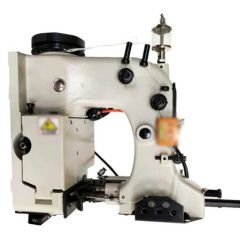 YY-1366 (USERS MANUAL) BAG CLOSING MACHINE HEAD, INSTRUCTION MANUALYY-1366 BAG CLOSING MACHINE HEAD, INSTRUCTION MANUAL FOR OPENRATOR SAFETY: - THIS MANUAL BOOK CONTAINS INSTRUCTIONS AND PRECAUTIONS FOR USING THE BAG CLOSING MACHINE HEAD. BE SURE TO READ AND UNDERSTAND THE MANUAL BOOK BEFORE USING THE MACHINES. - KEEP THIS MANUAL BOOK NEAR THE SEWING MACHINE FOR REFERENCE. BE SURE TO ATTACH THIS MANUAL BOOK TO THE MACHINE WHEN LENDING OR TRANSFER IT TO ANOTHER PERSON OR COMPANY. - PLEASE CONTACT THIS MANUAL BOOK FROM US IF IT LOST. - THE CONTENTS OF THIS MANUAL BOOK ARE SUBJECT TO CHANGE WITHOUT PRIOR NOTICE FOR IMPROVEMENT AND SAFETY PURPOSE. Learn More
YY-1366 (USERS MANUAL) BAG CLOSING MACHINE HEAD, INSTRUCTION MANUALYY-1366 BAG CLOSING MACHINE HEAD, INSTRUCTION MANUAL FOR OPENRATOR SAFETY: - THIS MANUAL BOOK CONTAINS INSTRUCTIONS AND PRECAUTIONS FOR USING THE BAG CLOSING MACHINE HEAD. BE SURE TO READ AND UNDERSTAND THE MANUAL BOOK BEFORE USING THE MACHINES. - KEEP THIS MANUAL BOOK NEAR THE SEWING MACHINE FOR REFERENCE. BE SURE TO ATTACH THIS MANUAL BOOK TO THE MACHINE WHEN LENDING OR TRANSFER IT TO ANOTHER PERSON OR COMPANY. - PLEASE CONTACT THIS MANUAL BOOK FROM US IF IT LOST. - THE CONTENTS OF THIS MANUAL BOOK ARE SUBJECT TO CHANGE WITHOUT PRIOR NOTICE FOR IMPROVEMENT AND SAFETY PURPOSE. Learn More -
 YY-3481 ATLANTA ATTACHMENT QUEEN SIZE TAPE EDGE, YEAR 2024, 300UX6 SEWING HEADYY-3481 ATLANTA ATTACHMENT QUEEN SIZE TAPE EDGE, YEAR 2024, 300UX6 SEWING HEAD TABLE DIMENSIONS: QUEEN (WIDTH 65 INCHES x LENGTH 106 INCHES x HEIGHT 65 INCHES) OPTIONS 1. 1345-KIT12 - DUAL SPOOL BINDER 2. 1375S88N - VIBRATING BINDER 3. 1345096 – LOCKSTITCH Learn More
YY-3481 ATLANTA ATTACHMENT QUEEN SIZE TAPE EDGE, YEAR 2024, 300UX6 SEWING HEADYY-3481 ATLANTA ATTACHMENT QUEEN SIZE TAPE EDGE, YEAR 2024, 300UX6 SEWING HEAD TABLE DIMENSIONS: QUEEN (WIDTH 65 INCHES x LENGTH 106 INCHES x HEIGHT 65 INCHES) OPTIONS 1. 1345-KIT12 - DUAL SPOOL BINDER 2. 1375S88N - VIBRATING BINDER 3. 1345096 – LOCKSTITCH Learn More -
 K-1291 INNOVATIVE SEWING TECHNOLOGY FOR HIGH QUALITY CUSHIONSREFERENCE NUMBER: K-1291 INNOVATIVE SEWING TECHNOLOGY FOR HIGH QUALITY CUSHIONS SPECIFIC FOR PRODUCING CUSHIONS OF SOFAS AND ARMCHAIRS, IN FOAM PARTIALLY OR TOTALLY COVERED WITH DACRON, EVEN WITH MECHANICAL PARTS, BABY MATTRESS, BEDSOFAS, CARAVAN BEDS WORKS WITH MANY KINDS OF MATERIALS: FOAM, DACRON (FOR FOAM THICKNESS: UP TO 20mm. ALSO HIGH DENSITY; FOR DACRON: UP TO 1000 GRAMS DENSITY), SYNTHETIC FIBER, COTTON, NON WOVEN, FEATHER, FIBRES, RECYCLED FIBRES AND FIBERBALLS. THE RESISTANT AND ELASTIC SEAM ALLOWS THE ELIMINATION OF THE USE OF GLUE, MAXIMIZING THE QUALITY OF THE PRODUCT AND GIVING ADDED VALUE TO THEIR PRODUCTION FACILITATES THE UPHOLSTERER OPERATIONS DURING THE SOFA CONSTRUCTION, GIVING ADVANTAGES THROUGHOUT ALL THE PRODUCTION PHASES QUANTITY AVAILABLE: 1 Learn More
K-1291 INNOVATIVE SEWING TECHNOLOGY FOR HIGH QUALITY CUSHIONSREFERENCE NUMBER: K-1291 INNOVATIVE SEWING TECHNOLOGY FOR HIGH QUALITY CUSHIONS SPECIFIC FOR PRODUCING CUSHIONS OF SOFAS AND ARMCHAIRS, IN FOAM PARTIALLY OR TOTALLY COVERED WITH DACRON, EVEN WITH MECHANICAL PARTS, BABY MATTRESS, BEDSOFAS, CARAVAN BEDS WORKS WITH MANY KINDS OF MATERIALS: FOAM, DACRON (FOR FOAM THICKNESS: UP TO 20mm. ALSO HIGH DENSITY; FOR DACRON: UP TO 1000 GRAMS DENSITY), SYNTHETIC FIBER, COTTON, NON WOVEN, FEATHER, FIBRES, RECYCLED FIBRES AND FIBERBALLS. THE RESISTANT AND ELASTIC SEAM ALLOWS THE ELIMINATION OF THE USE OF GLUE, MAXIMIZING THE QUALITY OF THE PRODUCT AND GIVING ADDED VALUE TO THEIR PRODUCTION FACILITATES THE UPHOLSTERER OPERATIONS DURING THE SOFA CONSTRUCTION, GIVING ADVANTAGES THROUGHOUT ALL THE PRODUCTION PHASES QUANTITY AVAILABLE: 1 Learn More -
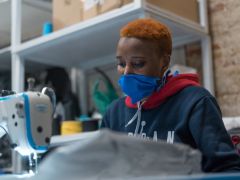 D-2388 What’s the Best Material for a Mask?
D-2388 What’s the Best Material for a Mask?Federal health officials have now recommended that we cover our faces with fabric during the coronavirus pandemic. But what material offers the most protection?
The Centers for Disease Control and Prevention has posted a no-sew mask pattern using a bandanna and a coffee filter as well as a video on making masks using rubber bands and folded fabrics found at home.
While a simple face covering can reduce the spread of coronavirus by blocking outgoing germs from coughs or sneezes of an infected person, experts say there is more variation in how much homemade masks might protect the wearer from incoming germs, depending on the fit and quality of the material used.
Scientists around the country have taken it upon themselves to identify everyday materials that do a better job of filtering microscopic particles. In recent tests, HEPA furnace filters scored well, as did vacuum cleaner bags, layers of 600-count pillowcases and fabric similar to flannel pajamas. Stacked coffee filters had medium scores. Scarves and bandanna material had the lowest scores, but still captured a small percentage of particles.
If you don’t have any of the materials that were tested, a simple light test can help you decide whether a fabric is a good candidate for a mask.
“Hold it up to a bright light,” said Dr. Scott Segal, chairman of anesthesiology at Wake Forest Baptist Health who recently studied homemade masks. “If light passes really easily through the fibers and you can almost see the fibers, it’s not a good fabric. If it’s a denser weave of thicker material and light doesn’t pass through it as much, that’s the material you want to use.”
Researchers say it’s important to remember that lab studies are conducted under perfect conditions with no leaks or gaps in the mask, but the test methods give us a way to compare materials. And while the degree of filtration for some homemade masks seems low, most of us — who are staying home and practicing social distancing in public — don’t need the high level of protection required for medical workers. More important, any face covering is better than none, especially if worn by a person who has the virus but doesn’t know it.
The biggest challenge of choosing a homemade mask material is to find a fabric that is dense enough to capture viral particles, but breathable enough that we can actually wear it. Some items being touted online promise high filtration scores, but the material would be unwearable.
Dressing Up for Work … at Home
Yang Wang, an assistant professor of environmental engineering at Missouri University of Science and Technology, worked with his graduate students to study various combinations of layered materials — including both air filters and fabric. “You need something that is efficient for removing particles, but you also need to breathe,” said Dr. Wang, who last fall won an international award for aerosol research.To test everyday materials, scientists are using methods similar to those used to test medical masks, which everybody agrees should be saved for medical workers who are exposed to high doses of virus from seeing infected patients. The best medical mask — called the N95 respirator — filters out at least 95 percent of particles as small as 0.3 microns. By comparison, a typical surgical mask — made using a rectangular piece of pleated fabric with elastic ear loops — has a filtration efficiency ranging from 60 to 80 percent.
Dr. Wang’s group tested two types of air filters. An allergy-reduction HVAC filter worked the best, capturing 89 percent of particles with one layer and 94 percent with two layers. A furnace filter captured 75 percent with two layers, but required six layers to achieve 95 percent. To find a filter similar to those tested, look for a minimum efficiency reporting value (MERV) rating of 12 or higher or a microparticle performance rating of 1900 or higher.
The problem with air filters is that they potentially could shed small fibers that would be risky to inhale. So if you want to use a filter, you need to sandwich the filter between two layers of cotton fabric. Dr. Wang said one of his grad students made his own mask by following the instructions in the C.D.C. video, but adding several layers of filter material inside a bandanna.
Dr. Wang’s group also found that when certain common fabrics were used, two layers offered far less protection than four layers. A 600 thread count pillow case captured just 22 percent of particles when doubled, but four layers captured nearly 60 percent. A thick woolen yarn scarf filtered 21 percent of particles in two layers, and 48.8 percent in four layers. A 100 percent cotton bandanna did the worst, capturing only 18.2 percent when doubled, and just 19.5 percent in four layers.
The group also tested Brew Rite and Natural Brew basket-style coffee filters, which, when stacked in three layers, showed 40 to 50 percent filtration efficiency — but they were less breathable than other options.
If you are lucky enough to know a quilter, ask them to make you a mask. Tests performed at the Wake Forest Institute for Regenerative Medicine in Winston-Salem, N.C., showed good results for homemade masks using quilting fabric. Dr. Segal, of Wake Forest Baptist Health, who led the study, noted that quilters tend to use high-quality, high-thread count cotton. The best homemade masks in his study were as good as surgical masks or slightly better, testing in the range of 70 to 79 percent filtration. Homemade masks that used flimsier fabric tested as low as 1 percent filtration, Dr. Segal said.
The best-performing designs were a mask constructed of two layers of high-quality, heavyweight “quilter’s cotton,” a two-layer mask made with thick batik fabric, and a double-layer mask with an inner layer of flannel and outer layer of cotton.
Bonnie Browning, executive show director for the American Quilter’s Society, said that quilters prefer tightly woven cottons and batik fabrics that stand up over time. Ms. Browning said most sewing machines can handle only two layers of fabric when making a pleated mask, but someone who wanted four layers of protection could wear two masks at a time.
Ms. Browning said she recently reached out to quilters on Facebook and heard from 71 people who have made a combined total of nearly 15,000 masks. “We quilters are very much in the thick of what’s going on with this,” said Ms. Browning, who lives in Paducah, Ky. “One thing most of us have is a stash of fabric.”
People who don’t sew could try a folded origami mask, created by Jiangmei Wu, assistant professor of interior design at Indiana University. Ms. Wu, who is known for her breathtaking folded artwork, said she began designing a folded mask out of a medical and building material called Tyvek, as well as vacuum bags, after her brother in Hong Kong, where mask wearing is common, suggested it. (DuPont, the maker of Tyvek, said in a statement that Tyvek is intended for medical apparel, not masks.) The folded mask pattern is free online, as is a video demonstrating the folding process. In tests at Missouri University and University of Virginia, scientists found that vacuum bags removed between 60 percent and 87 percent of particles. But some brands of vacuum bags may contain fiberglass or are harder to breathe through than other materials, and shouldn’t be used. Ms. Wu used a bag by EnviroCare Technologies, which has said it does not use fiberglass in its paper and synthetic cloth bags.
“I wanted to create an alternative for people who don’t sew,” said Ms. Wu, who said she is talking to various groups to find other materials that will be effective in a folded mask. “Given the shortage of all kinds of materials, even vacuum bags might run out.”
The scientists who conducted the tests used a standard of 0.3 microns because that is the measure used by the National Institute for Occupational Safety and Health for medical masks.
Linsey Marr, a Virginia Tech aerosol scientist and an expert in the transmission of viruses, said the certification method for respirators and HEPA filters focuses on 0.3 microns because particles around that size are the hardest to catch. While it seems counterintuitive, particles smaller than 0.1 microns are actually easier to catch because they have a lot of random motion that makes them bump into the filter fibers, she said.
“Even though coronavirus is around 0.1 microns, it floats around in a wide range of sizes, from around 0.2 to several hundred microns, because people shed the virus in respiratory fluid droplets that also contain lots of salts and proteins and other things,” said Dr. Marr. “Even if the water in the droplets fully evaporates, there’s still a lot of salt and proteins and other gunk that stays behind as solid or gel-like material. I think 0.3 microns is still useful for guidance because the minimum filtration efficiency will be somewhere around this size, and it’s what NIOSH uses.”
Learn More -
 V-0008 MODERN LATE MODEL MATTRESS MANUFACTURING MACHINES
V-0008 MODERN LATE MODEL MATTRESS MANUFACTURING MACHINESREFERENCE NUMBER: V-0008- MODERN LATE MODEL MATTRESS MANUFACTURING MACHINES PORTER SERGER FLANGER MODEL 2000 PORTER SERGER FLANGER MODEL 1000 PORTER DOUBLE BORDER SERGER PORTER AUTOMATIC LABEL ATTACHING MODEL PALS4000 ATLANTA ATTACHMENT BORDER MEASURE, HANDLE MAKER AND ATTACHER WITH AUTO CUT AND CLOSING MODEL 3300R ATLANTA ATTACHMENT TAPE EDGE , STAINLESS TOP WITH SINGER 300U SEW HEAD. MODEL 1345 ATLANTA ATTACHMENT RUFFLER MODEL 1335 ATLANTA ATTACHMENT HANDLE MAKER 4 INCH MODEL 1959 Y 28 B ATLANTA ATTACHEMENT BOX SPRING STAPLER GRIBETZ COMPUTERIZED CHAINSTITCH QUILTER 3 BAR BEIGE-86” GRIBETZ COMPUTERIZED CHAINSTITCH QUILTER 3 BAR BLUE-86” MECA TARGET QUILTER 3 BAR COMPUTERIZED CHAIN MODEL TA90 WITH PANEL CUTTER 1999- 90” MATTRESS AUTOTUFT TUFTING MACHINE – LIKE NEW , 200 MATTRESSES PER 8 HOUR SHIFT SPUHL ANDERSON PANEL CUTTER PC6 , 95 INCH
Learn More -
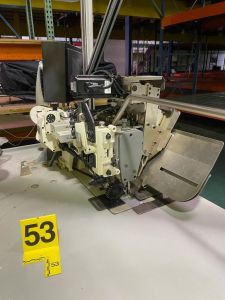 J-4957 PORTER RUFFLER, MODEL GPT-1100APJ-4957 PORTER RUFFLER, MODEL GPT-1100AP RAW FLYER FROM PORTER RUFFLER MEAU TYPE: AA – EF4 VOLTS: 24 V MOTOR INFORMATOIN: MITSUBISHI TYPE XL-G554-20Y VOLT: 200-240 NO NAMEPLATE ON THE MACHINE QUANTITY: 1 Learn More
J-4957 PORTER RUFFLER, MODEL GPT-1100APJ-4957 PORTER RUFFLER, MODEL GPT-1100AP RAW FLYER FROM PORTER RUFFLER MEAU TYPE: AA – EF4 VOLTS: 24 V MOTOR INFORMATOIN: MITSUBISHI TYPE XL-G554-20Y VOLT: 200-240 NO NAMEPLATE ON THE MACHINE QUANTITY: 1 Learn More -
 J-1563 COFFEE, SYRUP, LABELERS, CARTONERS AND SIMILAR EQUIPMENT
J-1563 COFFEE, SYRUP, LABELERS, CARTONERS AND SIMILAR EQUIPMENTCOFFEE, SYRUP, LABELERS, CARTONERS AND SIMILAR EQUIPMENT
Learn More
